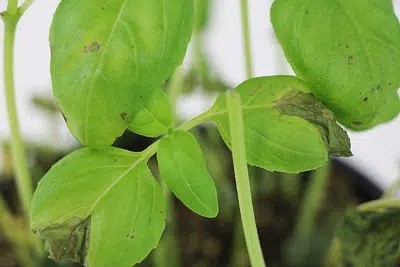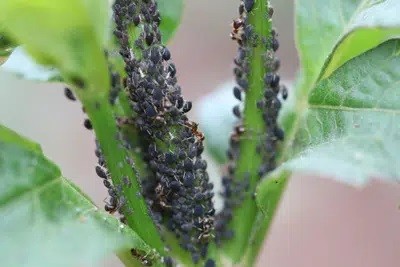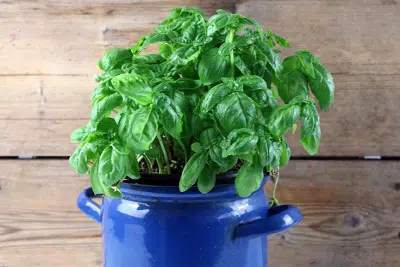Millions of basil are bought in pots every year. As potted plants, they are additionally a decorative eye-catcher for any kitchen. It is a pity that in most cases the basil quickly dies. If the first brown leaves appear, it can be assumed that health problems are already in full swing. Here it is necessary to find the cause and fix it.
Contents
Care
Whether the herb pot was bought cheaply in the discount store or more expensive and higher quality from the gardener, in any case, proper care is the key to a long life expectancy. If brown leaves form, it is often due to improper care. The cause can come from the following areas.
Location
Basil is sensitive to cold. Cold drafts and ambient temperatures of twelve degrees Celsius or below, it does not tolerate. Brown-colored leaves can be an indication that the location is too cold.
Light conditions can also be to blame for brown leaves. Some herb lovers mean too well with heat and sunlight. Burns are not infrequently the cause of leaves turning brown.
If you adhere to the following guidelines and choose a correspondingly more optimal location for brown leaves, you will quickly master the situation and save the basil from dying:
- on terraces and balconies the minimum temperature is above twelve degrees Celsius
- optimal growing conditions are at temperatures above 20 degrees Celsius to about 30 degrees Celsius
- winter temperatures between 18 and 20 degrees Celsius in a sunny location
- avoid direct hot midday sun in summer
- light conditions: sunny, best at a south window
Substrate
Basil is a highly nutritious plant that requires a lot of nutrients. Inferior substrate usually does not meet the requirements. In the herb pot belongs only high-quality substrate, which has the following properties:
- Loose texture
- Rich in nutrients
- High water permeability
- Good heatability
- pH between 6.5 and 7.2
- May contain light sand for improved water retention
Moisture

Basil likes a continuous soil moisture. But the soil should not be too wet, as this increases the risk of gray mold and stem rot. Brown leaves are often the first indication of overwatering and one of the diseases.
Ocimum basilicum also does not tolerate drought. The soil surface may well dry up slightly, but never completely dry up, because then the leaves will also quickly turn brown and dry out. Care should also be taken with the leaves. If they are wetted during watering, unsightly brown spots usually form.{infobox type=check|content=Tip: When the right watering time has come, can be determined well with the thumb test: if the thumb can be pressed more than two centimeters into the top layer of soil, there is no need for water – if less than two centimeters is to be watered}.
Pot
Basil needs sufficient space or distance from the individual clumps/stems. Often, herb pots are planted far too densely for sale, or far too many stems are planted for the pot size. Accordingly, nutrients are consumed more quickly and brown leaves form as a sign of undersupply/deficiency.
For five to six stems, a pot should have a diameter of at least 25 to 30 centimeters.
Diseases
Root and stem rot (Fusarium oxysorum).
If basil is kept too moist and/or waterlogging has developed, the result is often root and stem rot. This is a so-called wilt fungus. The water transport into the leaves is disturbed by this, so that the plant withers, which takes place via brown leaves. There is no control here. The basil should be disposed of together with the soil in the household waste.{infobox type=check|content=Tip: Never dispose of basil infected with the wilt fungus on the compost. The fungus spreads rapidly and can infect entire vegetable beds and garden plantings}.
Pests
Aphids (Aphidoidea)

Aphids do not stop at an Ocimum basilicum. The tiny parasites with green, black, brownish or yellow bodies usually attach themselves to the stems in colonies. They suck out the sap from the leaves. As a result, they turn brown. Clear signs can be seen earlier already by the sticky film on leaves. In case of light infestation, a powerful shower is enough to remove the pests.
Acronicta rumicis
The caterpillars of the dock bark owl like to sit on basil. There they feed on the sap of the plant. The leaves dry up and turn brown. The pests, which are about two to three centimeters long, can be recognized by their brown bodies with white spots. They are easy to pick off or can be shaken off.
Common meadow bugs (Lygus pratensis)
These pests range in size from 5.8 to 7.3 millimeters. Their body is slightly flattened and oval shaped. Depending on the sex, they have a light reddish brown to dark red or greenish brown color. On the hind part folded winglets appear. The juicy leaves of herbaceous plants serve as a food source. As with other pests, basil responds with brown leaves that dry and fall off. Prior to this, white sucking spots and leaf curling are noticeable. By the time the damage is discovered, the bugs have often already migrated. If they have not, ichneumon wasps can be used as natural predators.
Prevent brown leaves
Basil can always be found at bargain prices, especially in supermarkets. As a rule, Ocimum basilicum presents itself in a rich green, straight grown and looks healthy. Unfortunately, especially when it comes to bargain offers, it is often a commodity that is mass produced and grown. Even the freshest looking culinary herb can, with a little bad luck, start to form brown leaves immediately after purchase. The reasons are manifold.
Influencing the natural growth
Since the demand for the culinary herb is very high, growers are focusing on mass production. The priority is to be able to bring the plants to market as quickly as possible. Therefore, in many cases, a significantly faster growth is induced. This is usually achieved through the targeted use of artificial light. In addition, the soil temperature is optimized as required for vigorous growth spurts. Once they have reached the ideal size and a rich green, they go out for sale. They are not given time to strengthen or for the roots to take root properly after such manufacturing processes. This is usually at the expense of their lifespan. Many of these specimens start to get brown leaves after a few days and can die within two weeks. Therefore, the following tips should always be followed when buying:
- avoid particularly cheap bargain offers
- check the firmness of the roots by lightly pulling the herb
- rub on the leaves – intense aroma: strengthened plant – little to hardly any aroma: quick production
- do not be deceived by a fresh appearance due to lush green leaves
Substrate tip
Bargain prices should not be counted on a high-quality substrate that will provide good long-term care for the basil. Ocimum basilicum makes certain demands on a substrate. This is usually not taken into account because the cheapest variant allows higher profits. Or a blanket herbal soil is used for all herbs, but it has too few nutrients for basil. If brown leaves appear within a few days, this is often due to the substrate. Therefore, this should always be replaced after purchase with a high-quality substrate, as described previously under “Care – Substrate”.
Plastic film tip
If the pots are wrapped in plastic film, it creates a protected microclimate, so they can show their best side on the shelf for a few days. They provide support so that the weak plants do not fall over. But it is mainly the air conditions that exist through the film that can subsequently cause brown leaves. This is often the case when the film is simply removed after purchase. A new climate, a different temperature and a foreign environment cause problems for the herbs. Just a few degrees difference in temperature can cause the leaves to turn brown.
This can be prevented by pulling the film down only one to two inches each day. This will allow the herb to acclimate sufficiently well to the new environment.
Conclusion
If a basil gets brown leaves, the cause is either improper care, disease or pest infestation. Except for the wilt fungus, this can be easily controlled so that the herb plant does not die. In addition, if you take preventive measures, you have a good chance of preventing the formation of brown leaves.










